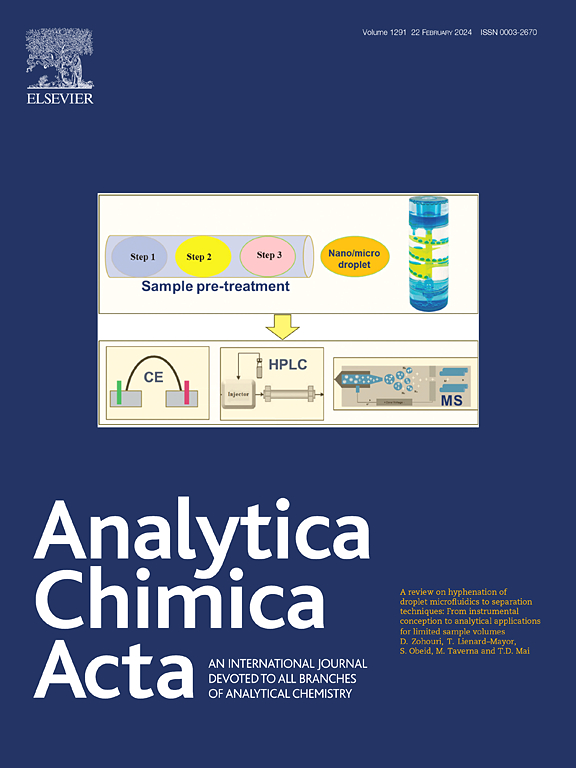Ultrasensitive detection of glutathione using CNs@Cr/g-C3N4 nanocomposite electrochemiluminescence in the presence of Cu2+
IF 5.7
2区 化学
Q1 CHEMISTRY, ANALYTICAL
引用次数: 0
Abstract
Background
Glutathione (GSH) serves as a pivotal antioxidant within biological systems. Dysregulated GSH levels are associated with a spectrum of pathologies, including carcinogenesis, hepatic dysfunction, and neurodegenerative disorders. Developing robust GSH detection methodologies is essential for assessing cellular health, facilitating early diagnosis of disease states, and tracking therapeutic efficacy. Electrochemiluminescence (ECL), which integrates electrochemical reactions with luminescent output, offers low background noise, making it highly suitable for biomolecule analysis. ECL-based GSH assays employing advanced nanomaterials are anticipated to amplify signals at low GSH concentrations, thereby playing a critical role in clinical diagnostics and biochemical research.
Results
This study presents a novel ECL sensor for the ultrasensitive detection of GSH, utilizing chromium/g–C3N4–loaded carbon nanospheres (CNs@Cr/g-C3N4) composites. Carbon spheres (CNs) and chromium (Cr) can improve the ECL properties of g-C3N4. However, the ECL signal of CNs@Cr/g-C3N4 is quenched (off-state) due to complex formation with Cu2+. Upon GSH addition, the higher coordination affinity between GSH and Cu2+ partially restores the ECL signal of g-C3N4 (on-state), allowing for quantitative GSH detection. Under optimized conditions, the linear detection range for GSH extends from 5.0 × 10−9 to 1.0 × 10−4 M with a limit of detection (LOD) of 3.3 × 10−10 M (S/N = 3), alongside high selectivity, stability, and reproducibility. More notably, the as-proposed ECL sensor was successfully applied to the quantification of GSH in real drug samples with excellent recovery rates.
Signifiance
In contrast to traditional techniques for GSH detection, our approach involves a one-time chemical modification of the electrode, eliminating the need for complex probe immobilization steps and streamlining the detection process. Besides, this “off-on” ECL sensing strategy, leveraging Cu2+ and CNs@Cr/g-C3N4, offers an innovative approach for developing advanced sensing systems. And this method is user-friendly, cost-effective, holding significant potential for applications in clinical diagnostics and pharmaceutical analysis.

Cu2+存在下CNs@Cr/g-C3N4纳米复合材料电化学发光超灵敏检测谷胱甘肽
谷胱甘肽(GSH)在生物系统中是一种关键的抗氧化剂。谷胱甘肽水平失调与一系列病理有关,包括癌变、肝功能障碍和神经退行性疾病。开发强大的谷胱甘肽检测方法对于评估细胞健康、促进疾病状态的早期诊断和追踪治疗效果至关重要。电化学发光(ECL)将电化学反应与发光输出相结合,具有低背景噪声,非常适合生物分子分析。基于ecl的谷胱甘肽检测采用先进的纳米材料,有望在低谷胱甘肽浓度下放大信号,从而在临床诊断和生化研究中发挥关键作用。结果利用负载铬/g-C3N4的碳纳米球(CNs@Cr/g-C3N4)复合材料,设计了一种用于超灵敏检测谷胱甘肽的ECL传感器。碳球(CNs)和铬(Cr)可以改善g-C3N4的ECL性能。然而,CNs@Cr/g-C3N4的ECL信号由于与Cu2+形成络合物而被淬灭(灭态)。加入GSH后,GSH与Cu2+之间较高的配位亲和力部分恢复了g-C3N4的ECL信号(on-state),从而可以定量检测GSH。在优化条件下,GSH的线性检测范围为5.0 × 10−9 ~ 1.0 × 10−4 M,检出限(LOD)为3.3 × 10−10 M (S/N = 3),具有较高的选择性、稳定性和重复性。更值得注意的是,所提出的ECL传感器成功地应用于实际药物样品中谷胱甘肽的定量,具有优异的回收率。与传统的谷胱甘肽检测技术相比,我们的方法涉及对电极进行一次性化学修饰,消除了复杂的探针固定步骤的需要,简化了检测过程。此外,这种利用Cu2+和CNs@Cr/g-C3N4的“off-on”ECL传感策略为开发先进的传感系统提供了一种创新方法。该方法操作简便,成本效益高,在临床诊断和药物分析方面具有很大的应用潜力。
本文章由计算机程序翻译,如有差异,请以英文原文为准。
求助全文
约1分钟内获得全文
求助全文
来源期刊

Analytica Chimica Acta
化学-分析化学
CiteScore
10.40
自引率
6.50%
发文量
1081
审稿时长
38 days
期刊介绍:
Analytica Chimica Acta has an open access mirror journal Analytica Chimica Acta: X, sharing the same aims and scope, editorial team, submission system and rigorous peer review.
Analytica Chimica Acta provides a forum for the rapid publication of original research, and critical, comprehensive reviews dealing with all aspects of fundamental and applied modern analytical chemistry. The journal welcomes the submission of research papers which report studies concerning the development of new and significant analytical methodologies. In determining the suitability of submitted articles for publication, particular scrutiny will be placed on the degree of novelty and impact of the research and the extent to which it adds to the existing body of knowledge in analytical chemistry.
 求助内容:
求助内容: 应助结果提醒方式:
应助结果提醒方式:


